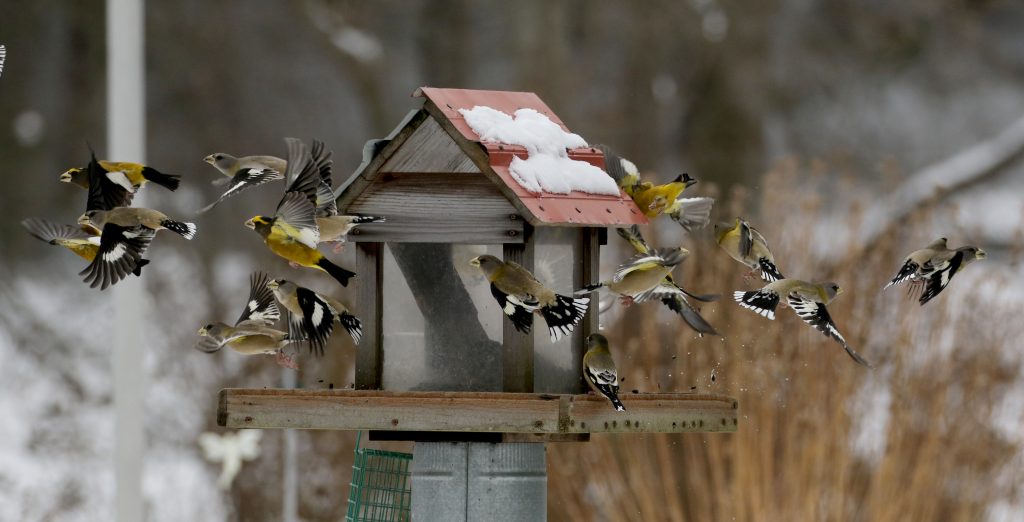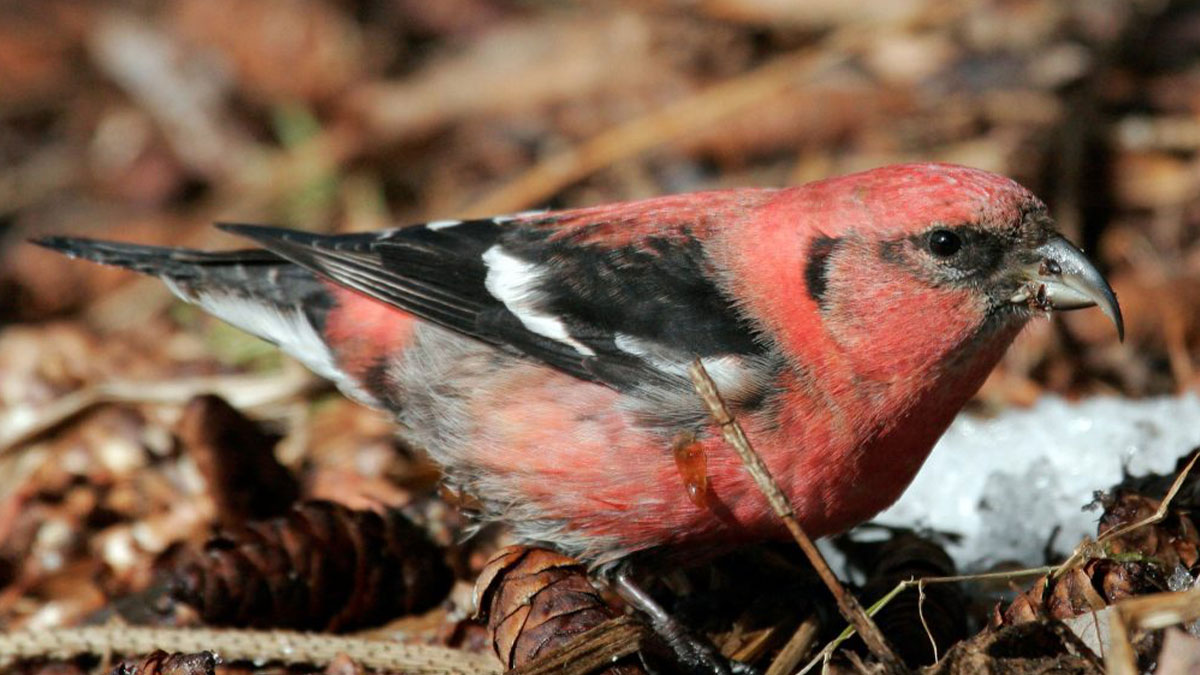Post Image: ©Mark Peck
GENERAL FORECAST 2021-22:
Forecasts apply mainly to Ontario and adjacent provinces and states. Three irruptive non‐finch passerines whose movements are often linked to finches are also discussed. To learn more, subscribe and follow the blogs, news and updates at The Finch Research Network, and finch wanderings this fall and winter on eBird.
The year’s flight should not be an irruption year, but some southward movement should be into their normal southern wintering areas in Southeastern Canada and Northeastern United States. However, there will be movement of most finches varying by species and location in the boreal forest. So you will be able to find most species, but it won’t be like last year when they came to so many people’s backyards, this year you’ll very likely need to go search for them.
Extreme weather this summer has played a significant part in this winter’s forecast. With over 2000 forest fires stretching from Northwestern Ontario to British Columbia, record-setting high temperatures across much of western Canada (up to 49.6 Celsius/ 121 Fahrenheit in Lytton British Columbia), and severe droughts in wide areas westward from Lake Superior, food sources have been significantly impacted.
There is a cone crop this year from Lake Superior eastward in the boreal forest. It is, however, mostly a mosaic of poor to average crops. Along the southern edge of the boreal forest, a belt of good to bumper food crop is reported from Lake Superior eastward through Central Ontario, southern Quebec Atlantic Canada to Newfoundland, southward to Northern New England, and New York state.
This should be a good winter to see finches in traditional hotspots such as Ontario’s Algonquin Park, Quebec’s Laurentian Mountains, New York’s Adirondack Mountains, Atlantic Canada and the northern New England states.
INDIVIDUAL FORECASTS:
Pine Grosbeak
There is a widespread good to excellent crop of Mountain ash berries Lake Superior eastward. This should keep most Pine Grosbeaks closer to home this winter.
Drought has most impacted Mountain ash and other berry crops west of Lake Superior, with many berries shrivelling on the stem. The Mountain ash crop in this area westward though the boreal forest generally appears poor with some areas of excellent crops. Areas in the upper Midwest states and cities in western Canada may see flocks of hungry Grosbeaks searching for fruiting ornamental trees and well-stocked feeders with black oil sunflower seeds.
White-winged Crossbill
With very poor cone crops reported from Northwestern Ontario westward into Alaska, two visible movements of White-winged Crossbills have already been seen this summer. In Western North America, White-winged Crossbills moved south into Southern British Columbia/Alberta, and Pacific Northwestern States with a few reported recently as far south as Utah.
During late June into July, there was an eastward movement into the robust spruce crop areas in eastern North America, particularly in Maine, Maritime provinces and Newfoundland. This winter, expect to see White-winged Crossbill from Central Ontario eastward to Newfoundland and southward into northern New York and New England, visiting traditional winter finch hotspots. We may even see White-winged Crossbills away from the forests using heavy crops on planted native and ornamental spruces within urban environments.
Crossbills remaining in the boreal forest will move around in search of food, and thus, some movements may be seen this fall/winter into areas like the upper Midwest states as they look for suitable cone crops.
The crossbills in areas with good spruce crops are likely breeding this winter so expect to encounter streaked juveniles in the flocks.
Red Crossbill
There is a good spruce and hemlock crop throughout Central Ontario to southern Maritimes and northeastern states. Red Crossbills are in their usual conifer haunts, and this should continue through much of the winter. Red Crossbills will also be found south of the boreal zones where there are good Norway Spruce forests. Don’t expect to see much in the way of any irruption from the west (Type 2 being maybe a wild card), but expect to continue to see some Type 10s in Great Lakes, Algonquin, Maritimes, Adirondacks, Northern New England and the usual areas of Maine, and very small numbers of Types 1, 2 and 3 mixed in here and there. Type 1 Red Crossbills are more common in western Berkshires of Massachusetts and southern New York into Pennsylvania and the Appalachians. Types 2 Red Crossbills, and maybe a few Type 4, should be slightly more common in the western Great Lakes states again.
The types are usually impossible to identify without recordings of their flight calls. Recordings can be made with a smartphone and identified to type. Matt Young (info@finchnetwork.org) will identify types if you email him your recordings or upload them to an eBird checklist. Recordings uploaded to eBird checklists are deposited in the Macaulay Library.
Purple Finch
Most years, Purple Finches migrate south out of Canada. This year the majority of birds should leave, but we anticipate some will remain in Central Ontario to the Maritime provinces.
Between one observer reporting “a crazy number of purple finches” in mid-August and L’Observatoire d’oiseaux de Tadoussac having even stronger movements southwestward in Quebec this year than 2020, this species appear to continue to benefit from an abundant food source during the breeding season in the four large Spruce Budworm outbreaks in eastern Canada.
At feeders, they prefer black oil sunflower seeds.
Common and Hoary Redpolls
Given the seed crops on birches, alders and spruce are average to good most redpolls will likely stay in the north Lake Superior eastward. As the winter progresses, some trickling down of flocks into Southern Canada and neighbouring border states may occur.
To the west, the weather has impacted the tree species preferred by redpolls in Northwestern Ontario to Alaska. Therefore, there should be some movement southward into areas with some tree seed crops and weedy fields.
At feeders, redpolls prefer nyjer seeds served in silo feeders. Watch for Hoaries in flocks of Common Redpolls
Pine Siskin
With the excellent spruce, hemlock and eastern white cedar crop across southeastern Canada and Northeastern border states, most Pine Siskins in the east should remain in this area for the winter.
Pine Siskins should move south along mountain ranges similar to the White-winged Crossbills with the poor spruce crop in western North America. There should also be a southeastward movement through the boreal forest in search of food. Expect some of this ymovement to bring Pine Siskins into the upper Midwestern states and possibly beyond searching for food. This entertaining species prefer nyjer seeds in silo or sock feeders.
Evening Grosbeak
In the fall of 2020, we experienced a generational irruption of Evening Grosbeaks southward. With that, we may experience an echo flight this fall. This year there is the ‘belt of food’ between the four large Spruce Budworm outbreaks and where they irrupted too last winter.
In the east, expect some birds to remain in the boreal forest and others to move south into Central Ontario, Southern Quebec, the Maritime provinces, New England states, New York, and maybe Pennsylvania for the winter.
Evening Grosbeaks in Northwestern Ontario westward towards Alberta should move out of the boreal forest looking for feeders in towns or suitable food sources further south. Evening Grosbeaks in the mountains of western Canada may move southward as well.
At platform feeders, Evening Grosbeaks prefer black oil sunflower seeds. Away from feeders, Evening Grosbeaks will look for maple and ash trees still holding seeds. See the link below for Evening Grosbeak call types.
THREE IRRUPTIVE PASSERINES:
Movements of these three passerines are often linked to the boreal finches.
Blue Jay
There will be a moderate flight along the north shorelines of Lakes Ontario and Erie. Oak, beechnut and hazelnut crops are variable in central and southern Ontario, ranging from none to good. Insect defoliation has damaged many seed crops. A good number of Blue Jays should visit feeders this winter in Southern Canada.
Red-breasted Nuthatch
While there currently appears to be a small ‘echo flight’ of this species, most Red-breasted Nuthatches in the east should remain in the food belt in the northeast. Birds west of Lake Superior should be moving looking for food this fall. At feeders, this species prefers black oil seeds, suet, and peanuts.
Bohemian Waxwing
Most Bohemian Waxwings in eastern North America will remain in the boreal forest this winter because mountain‐ash berry crops are good to excellent from Lake Superior to Newfoundland and Labrador. West of Lake Superior, there should be more movement of flocks in search of areas with Mountain Ash crops. If some move south, this species will forage on Buckthorn and planted European Mountain Ash berries and ornamental crabapples.
Shirt Link:
For a commemorative Winter Finch Forecast shirt where proceeds will go towards the study and conservation of finches and their habitats globally see here: https://finchnetwork.org/shop
Finch Information Links:
- Crossbills of North America: Species and Red Crossbill Call Types. https://ebird.org/news/crossbills-of-north-america-species-and-red-crossbill-call-types/
- Finch Research Network with finch species information https://finchnetwork.org/
- Evening Grosbeak Call Types https://finchnetwork.org/species/grosbeaks/the-evening-grosbeak-project To support research and conservation for this species of conservation concern: https://finchnetwork.org/donate
- Previous Winter 1999-2019 http://www.jeaniron.ca/WFFindex.htm
- 2020 Winter Forecast https://finchnetwork.org/winter-finch-forecast-2020
I like to thank the many birders, naturalists, biologists, foresters and others whose tree seed reports allowed me to make this forecast:
Charmaine Anderson (Northern ON), Nick Anich (Northwestern WIS), Cathy Antoniazzi (Prince George BC), Denis Barry (Algoma, Haliburton and Durham ON), Ryan Brady (Northwestern WIS), Mike Burrell (Southern and Central ON), Keith Bruce (Kodiak AK) Gray Carlin (Northern ON,) Geoff Carpentier (Northwestern ON and Durham Region ON), Joan Collins (Adirondacks NY), Ian Cook (Northwestern SK), John Cordon (Flin Flon MB), Jamie Cornelius (OR), Iain Cruickshank (Vancouver Island BC), Jason Dain (Nova Scotia), Michael Dawber (Rainy River District ON), Clinton Dexter-Nienhaus (Sax-Zim Bog and Northern MN), Bruce Di Labio (Eastern ON), Carter Dorscht (Algoma District ON), Jessé Roy-Drainville (Observatoire d’oiseaux de Tadoussac QC), Bob Dunlap (Eastern MN), Dave Elder (Atikokan ON), Michael Ferguson (Northwestern SK) Harold Fisher (Prince Albert SK), Marcel Gahbauer (Eastern ON), Liron Gertsman (Vancouver Island BC), David Govatski (NH and VT), Violet Hall (Northern ON), Danica Hogan (Northwest Territories), Susan Kielb (Upper Pennisula MI), Carolina Lambert ( Banff and Canmore AB), Sarah Lamond (Algonquin Park ON), Derek Lovitch (Adirondacks and New England), Stuart Mackenzie (Nipissing District ON), Bruce Mactavish (Newfoundland), Angela Mcdonald (Nova Scotia), Stacy McNulty (Adirondack NY), Stephane Menu (Bruce Cty ON and northwestern SK), Eric and Anne Mills (Nova Scotia), Alex Mills (Northwestern SK), Peter Mills (Algonquin Park ON), Bruce Murphy (Hilliardton Marsh Research & Education Centre, Timiskaming District ON), Stephen O’Donnell (Parry Sound District ON), Henrique Pacheco (Algonquin Park ON), Mark Peck (Haliburton ON), Justin Peter (Southern ON), Fred Pinto (Nipissing District ON), Rayfield Pye (Newfoundland), Brian Ratcliff (Lake Superior and Northern ON), Peter Simmons (Algonquin Park ON), Scott Stoleson (Allegheny Nat. Forest PA), Ron Tozer (Algonquin Park ON), Declan Troy (Alaska),David Yeany (western PA),.and Matt Young (NY).
Thank you to Mark Peck for providing the White-winged Crossbill photo. Thanks to Susan Hall, Matt Young, and Ron Pittaway for reviewing the forecast.

23rd Annual Winter Finch Forecast: The first was posted to the Ontbirds and Birdchat listservs in 1999.
Tyler Hoar Oshawa, Ontario. Finch Research Network, September 26, 2021.

